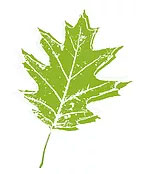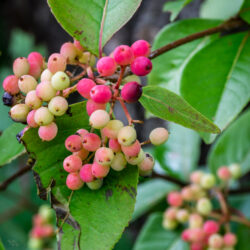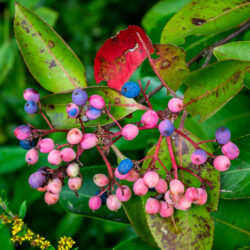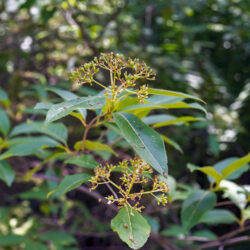Etymology
Viburnum is Latin for the wayfaring tree. Nudum means naked, nude, or bare; Cassinoides means “resembling Ilex cassine,” which is a species of holly. Viburnum cassinoides is commonly called witherod viburnum. Withe (from Old English) means flexible twig and rod means slender shoot or stem.
Native Habitat
This plant is native primarily to northeastern North America (hence the occasional common name of northern witherod) where it is typically found in low woods, fields, swamps, marshes, pond peripheries and bogs.
Garden Uses
Attractive flowers, showy fruit clusters, and tolerance for wet conditions make this an excellent choice for the garden. Plant in acidic, moist to occasionally wet areas with full sun to partial shade, such as along ponds, streams, and bogs, or in water or rain gardens. It’s potential to form a dense thicket makes it a good choice for hedges and or for naturalizing a space, and it looks great when planted in groups or as specimens/accents. For best cross-pollination and fruit display, plant in groups.
Overview
Wild raisin is a multi-stemmed, upright-spreading, low-maintenance deciduous shrub that typically grows 5 to 6 feet tall. It prefers sun to part shade in acidic, moist, well-drained soils but can be adaptable. It is more tolerant of wet soil than other viburnums. The opposite, shiny leaves have vibrant red fall color. The blooms are showy and fragrant in flat-topped clusters and give way to showy berries of various colors. Berry production is best if more than one shrub is planted. Viburnum leaf beetle can be a problem for this plant. Occasional insect pests include aphids, borers, nematodes, scale and thrips. Occasional disease problems include anthracnose, leaf spots and powdery mildew.
Spread
Wild raisin spreads to about 5 or 6 feet wide. Space plants 5 feet apart at the time of installation.
Leaves and Stems
3 1/2 to 4 inch long, glossy, dark green leaves are opposite, elliptic to ovate, and entire. Leaves turn orange-red to red-purple in the fall. Stems are slender, shiny and reddish-brown. Buds are valvate (do not overlap), slender, up to 1/2 inch long, and pinkish brown.
Flowers
Flat-topped clusters (cymes 2-5" wide) of creamy white flowers (3/16" across) appear in June.
Fruit/Seed
Fruits emerge in clusters in late summer, transitioning from light pink to deep pink, then to blue, and eventually to a purplish-black in the fall. Each oval fruit is about ⅓ inch long. These clusters are distinctively attractive because all of these colors can appear simultaneously. The fruits are acidic but edible (preferably after a frost).
Wildlife Associates
The dense thicket formed by the branches provides a stable habitat and cover for many animals. It may serve as a host plant for the spring azure butterfly and hummingbird clearwing moths. Its fruits are consumed by songbirds, grouse, wild turkeys, and squirrels, and its twigs and leaves are grazed by white-tailed deer.
Propagation
Warm stratification of seed for 60 days followed by cold stratification for 90 days at 34-41 degrees F. Propagation by cutting is also possible.
Ethnobotanical Uses
Fruits are said to taste like a raisin or date. The fruit has a single large seed, so there is not much flesh. Great in a jam or as a sauce where you can sieve out the seeds. The fruit was used by several native American tribes, including the Abnaki and the Algonquin. The leaves reportedly may be used as a pleasant-tasting tea substitute. Northern wild raisin also has some medicinal uses. The bark and root bark of the shrub reportedly was used as a tonic. An infusion has been used as a treatment for fever and convulsions. An infusion of bark reportedly was used as a wash for a sore tongue.
Garden Location
Residential Garden (see garden map)
Sources
North Carolina Extension Gardener Plant Toolbox
The University of Tennessee Institute of Agriculture
Plant Profile by Rachel Emus





